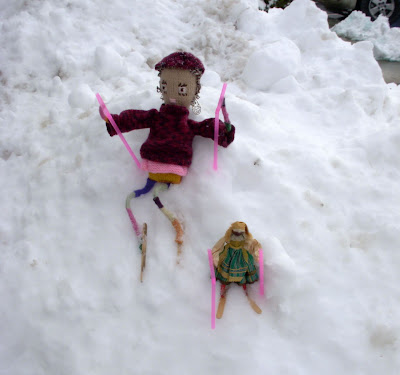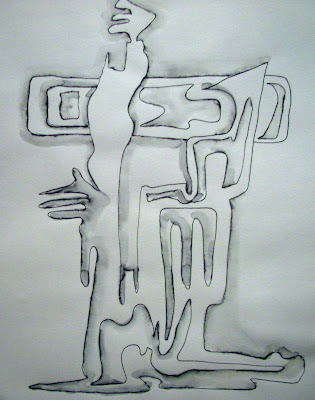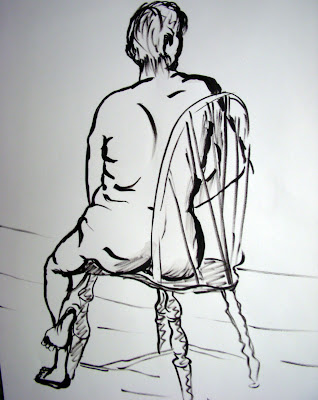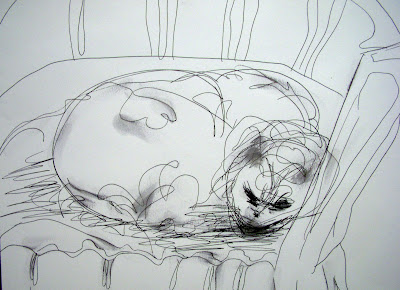I had a lot of fun with image transfer in the last few years, and I'm showing you a number of images which are a first: you are the first people outside the studio to see them, and I'm hoping to show them at some point, but this is their first view of daylight.
Image transfer is the literal moving of an image, just the image, not the paper or support, to another surface. We did it as kids when we pressed an eraser against the funny pages and got an image on the eraser which we could then press onto another piece of paper, very exciting stuff.
I did a whole range of ways of doing this, involving art that delved into itself, as I'll explain as we go along. I should mention at the outset that you should not be doing image transfer with anyone work but your own, if you plan on presenting it as your own work. These images are all from my own original art.
Some kinds of art, unless you have a studio with a fume hood, which I don't, are best done out of doors. In this northern climate, that means summer. Image transfer is a good example of this, since you use a solvent (I used acetone) to move the image and it's much better to be away from any risk of inhaling or setting fire to it in the process.
I'm fiercely careful about safety in art materials, never allow spray adhesive anywhere in my vicinity, never use spirit gum, never work with pastels indoors, since the dust that comes off is toxic, all that. So I like to emphasize the importance of working with solvents out of doors if you don't have a powerful suction type of fan system in the studio, and I don't know anyone who does.
So, cautions said, here's a wonderful experience I had incorporating film photography, drawing, environmental art, the kind of work that draws you in and you can't plan it ahead of time, since the work tells you what to do as you go.
All these pieces are small, since that's often the nature of image transfer, few bigger than maybe 8 x 10 inches in size. Big works in small sizes! And all are transferred onto Arches hotpress paper, wonderful paper.
The range of approaches I explain as we go, in case you want to try it for yourself.A lot of these images are taken from a very small radius around my house, since part of what I wanted to do was find the art of the neighborhood, without feeling you have to make an expedition to find subject matter.

Water shutoffs outside the building. This was a film photograph which I got developed, two copies, then assembled them in opposition to each other, then used solvent to move the image onto the hotpress paper. Photos face down on the paper, solvent liberally doused over the back, gently stroke the back of the photos to make sure the image transfers well.

This was a monotype which I created freehand, then photographed, doubled, and transferred.

Painting, photographed, and transferred

This tree filled with rocks was part of a series of environmental art pieces I created in the trees out behind the house, using rocks from around the tree, to make a nonintrusive art piece. There's a golf course behind there, and golfers wander about looking for stray golfballs, so they see these things.
One pointed this tree out to me one day, not knowing I had anything to do with it, and said, will you look at that? how do you suppose that could have happened? In the end between freezing and thawing and the assistance of squirrels, a lot of the rocks were redeposited on the surrounding grass over the next year.
I photographed and then transferred this. But I also made drawings of the tree and others, and photographed the drawings and transferred them, too. This make your art go through dimension after dimension, showing you interesting changes as it goes.

Continuation of the environmental pieces.

Shadows through the fence around the dumpsters!

One of the neighbors had these two chairs out on the porch, and they were so eloquent that I had to get a picture, and then transfer it, to catch a dreamy, soft focus feeling about it.

Much sharper image, because this is photography transferred.

This was one of those winter scenes where nature makes the art and you just get to record it. The patio after a big snowfall, photographed then transferred.

This scene you also saw in a charcoal drawing in an earlier post -- I made an entire series of charcoal drawings of this scene. This is the original quick snap I took at the shrub nursery, of trees burlapped for the winter, which I transferred. It's eerily like a crowd of people, even when you know it's shrubs.

Engineering art! one photograph of the top of the heating unit at our house, doubled, arranged in opposition, then transferred.

This was an ink monotype, but this time photographed and doubled before transfer.

This is two images, a comment on the similarities between flowers and shells, taken at the shore, the only piece in this series made more than fifty yards from my front door.

This was a monotype, which I created then photographed and transferred, to give it a soft focus, evocative feel.

This is a couple of electrical junction boxes, photographed, doubled, related and transferred.

The artist's hand shadow on an iron cover, while I took the picture with the other hand. Two images, related, then transferred.

This is a painting, made with soluble crayon, and transferred.

Another painting, same idea.

Flower pushing through a gap in the fence.

Another winter scene, this one the markings done by the cable guys after a snowstorm, and the flags they left after they'd done whatever cable guys do. Double image, related in opposition, then transferred.

Cable boxes again, I get a lot of mileage out of the local engineering. But they're beautiful, symmetrical with oddness too.






















































